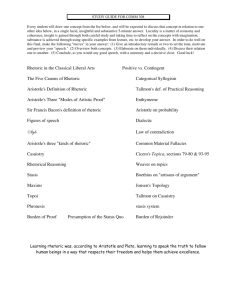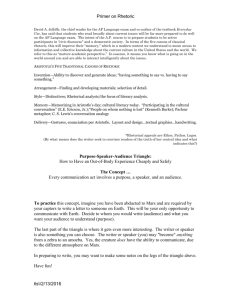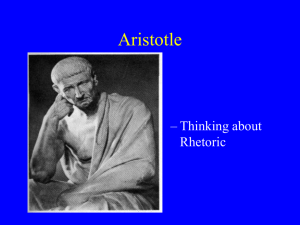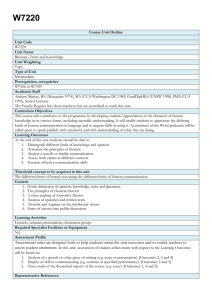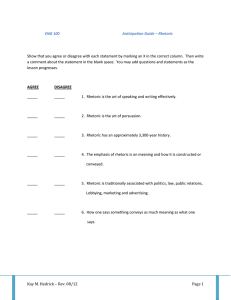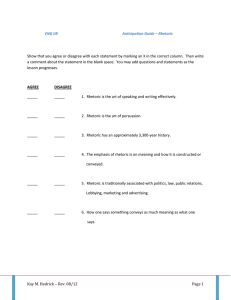Lecture: Aristotle and Rhetoric Monday, September 24, 2001 2:55 - 4:20
advertisement
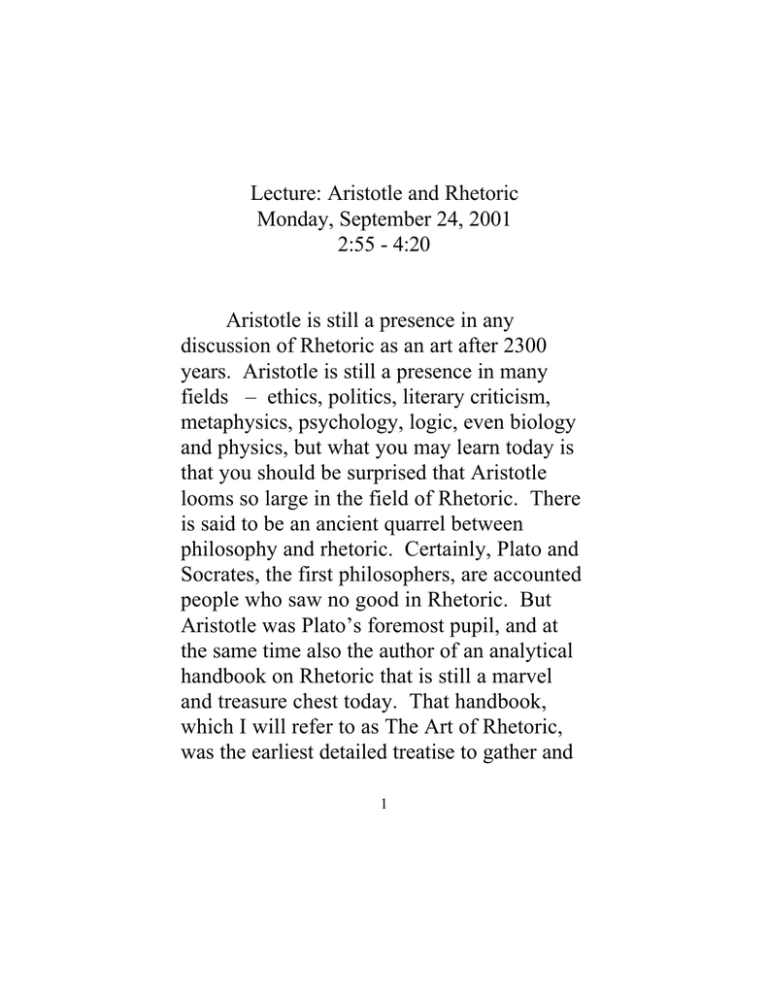
Lecture: Aristotle and Rhetoric Monday, September 24, 2001 2:55 - 4:20 Aristotle is still a presence in any discussion of Rhetoric as an art after 2300 years. Aristotle is still a presence in many fields – ethics, politics, literary criticism, metaphysics, psychology, logic, even biology and physics, but what you may learn today is that you should be surprised that Aristotle looms so large in the field of Rhetoric. There is said to be an ancient quarrel between philosophy and rhetoric. Certainly, Plato and Socrates, the first philosophers, are accounted people who saw no good in Rhetoric. But Aristotle was Plato’s foremost pupil, and at the same time also the author of an analytical handbook on Rhetoric that is still a marvel and treasure chest today. That handbook, which I will refer to as The Art of Rhetoric, was the earliest detailed treatise to gather and 1 explain what, still today in the 21st century, are the central doctrines of rhetoric. It is the first theory of rhetoric. My talk will have three unequal parts. First, Aristotle, the man, his works, and his impact. Second, The Art of Rhetoric in large, as it were, its size, general structure, preservation, and impact through the centuries. Finally, I will get down to discussing what I regard as the heart of the Art of Rhetoric, the introductory chapters in which Aristotle explains the nature and structure of the art of Rhetoric, with such clarity and force that his ideas and language have seeped, in one form or another, into the entire rhetorical tradition although, in the pedagogical practice of that tradition, Aristotle played only a secondary role; teachers of rhetoric, generally speaking, have relied on Hermagoras of Temnos as the inventor of staseis and Cicero and Quintilian and their successors. 2 What I say in praise of the Art of Rhetoric only means that, for us looking back, Aristotle gives elegant and enlightening expression to what had become the stock in trade of many; he himself says as much, he shaped rather than invented rhetoric although before his time it was, as it were, without voice, since instruction for the most part consisted in close study of a master’s works, as if, Aristotle says, one were to teach shoemaking by throwing down a heap of shoes in front of the students and asking them to study the shoes. But Aristotle not only provides classic statements of widely recognized rhetorical elements, he also gives a forceful and coherent statement of a theory of rhetoric in which he arranges these elements into a whole that possesses great force and integrity. I. Aristotle the Man, his Works and their History 3 Aristotle the man (384-321 BC) was born into a family of hereditary physicians (at a time when the fruits of Hippocrates’ revolution in medicine were available) in a small polis, city-state, in northern Hellas – Stagiros. He came to Athens to study with Plato when he was 17 (367), formed lasting friendships and agreements there (Plato called him the mind or insight of the Academy), and stayed for 20 years until Plato’s death as student and teacher. During this period as he matured he began to give lectures on, among other subjects, Rhetoric. The lectures on Rhetoric were said to have been delivered in the evening because they were popular and attended by many. After Plato’s death he was drawn away from Athens for a dozen years, but was always in the company of friends from the Academy. For two years he resided at the 4 court of Philip of Macedon and had some hand in the education of Alexander the Great. He was always known in Athens, to which he returned in 335, as sympathetic to Macedonian hegemony and a close friend and advisor of Antipater, the Macedonian commander in Europe at that time. After Alexander’s death in 322 Aristotle left Athens and went to Chalcis, a couple days distant, for fear of Athenian reaction against the Macedonians. ‘I do not want Athens to make the same mistake twice,’ he is supposed to have said referring to Athen’s regretted execution of Socrates. Except for the last year of his life in Chalcis, he lived and worked in Athens after 335 BC. These were busy years. He organized a congenial group of colleagues and students, a school, in the shadow of a temple of Apollo the Wolf-like (the Lyceum). There he lectured and studied, picking up the 5 threads of his former stay in Athens. He energetically organized large expeditions to gather information and documents about other forms of government ( Constitution of Athens) and biological specimens (officially attached to Alexander’s triumphant march through Egypt, the Middle East, the Persian territories and Western India). This was work he had already begun years before. But his real work in these years was completing his huge oeuvre – 23 volumes in the Loeb Library edition and comparable in scope and size to St. Thomas’ Summae or even today’s Encyclopedias – but really unique because the work consisted primarily of his analysis; and his was the first attempt to elaborate a departmentalization of knowledge, but he also sought to cover, in his own works, all those departments. In character these works of Aristotle have always been dismissively contrasted with 6 the dialogues of Plato as ‘lecture notes.’ They are spare, allusive, deeply passionate, often witty, and difficult reading. They must have been so to the ancient Athenians, and they are doubly so for us today covered over by many palimpsests of translation and interpretation. It makes the clarity of the Art of Rhetoric doubly amazing. Aristotle’s works from the Lyceum (he wrote some dialogues during his earlier stay in Athens, but only stray quotes from them are preserved) are all in the form of treatises or lectures (thus the lecture note characterization). Like all ancient manuscripts, it is anyone’s guess how many hands were employed in creating the text, but – despite many modern interpreters’ ill-fated attempts to peel away the text into many layers of interpolations by ‘other hands,’ an effort increasingly abandoned by scholars today — most of the works have sufficient internal coherence to stand on their own feet for the 7 patient reader. But it takes some work! Most of the works of Plato and Aristotle are preserved, as compared to the general destruction of the work of other ancients of whose works only a small part has come down to us. They owe that preservation to their intrinsic value and, for many centuries, to the work of the educational institutions Plato and Aristotle left behind. The Lyceum had as one of its most main functions, so long as it was active, the preservation of the corpus. But without repeated ‘re-discoveries’ of Aristotle through history by Jewish, Islamic, and Christian thinkers, Aristotle would not be quite so much intertwined with current scholarly and scientific thought as he is. Indeed, higher education among all the Peoples of the Book show the impress of Aristotle, or of authors deeply influenced by Aristotle, and none more so than in the European Christian tradition. 8 By the 16th century, moreover, the very success of the Aristotelian revival by St. Thomas led to Aristotle’s achieving supercanoncial status. Modernity was born with a war-whoop of anti-Aristotelianism. Notwithstanding, Aristotle continues to be read and considered in the many fields noted above. Aristotle’s insights are still alive, vital and part of our heritage today. The Aristotelian corpus has survived in bulk and in remarkably good shape. In part, it has been preserved, repeatedly, by the renewing production of new recensions or editions of the Greek. The last major textual review of the entire corpus of the Greek tests (tested many times since for individual works) was the Bekker edition (1830 - 1851) in Germany. The convention today is to cite Aristotle’s chapter and verse by using the Bekker page and column numbers. Bekker’s huge quarto texts were organized two columns to the page. Thus the Art of 9 Rhetoric runs from 1355a to 1419b of the Bekker volume in which the work appears. Manuscript and incunabula texts are, for most of Aristotle’s works, numerous and reliable. As far as we are concerned, the most recent assembly of scholars to review the reliability and integrity of the Aristotelian texts found that there was no reason to question the authenticity of the text of the Art of Rhetoric. II. The Art of Rhetoric as a work in large Aristotle’s Art of Rhetoric is a relatively large book (65 Bekker pages) and swells to 312 pages in On Rhetoric: A Theory of Civic Discourse, George Kennedy’s 1991 annotated translation, which I recommend. The Art is divided into three books of roughly equal length. The third book stands apart from the first two. The first two books are devoted to 10 the structure of rhetorical invention. The other traditional Ciceronian parts of rhetoric: delivery, style, memory and organization (or parts of a speech) all are treated in the third book. There is even respectable evidence that our three part version of the Art of Rhetoric was, for many centuries, treated as two separate works, one on how the thought of the speech is developed (Books I and II), and the second (III) on the actual composition of artful speeches. I think that this is important, for it underlines the extent to which Aristotle’s rhetoric is an inventional rhetoric, a rhetoric that is concerned with thoughtful understanding of how plausible argument is developed, what its uses and limits are, and how speech and communication should be understood. It is a rhetoric that aims at getting at the truth of matters. I believe there are many kinds of 11 rhetoric, and we move in our thought and speech from one to the other of them; but rhetoric as invention has a special role and force. I believe many of the classic works leading to the revival of interest in rhetoric in the 20th century (after its apparent demise in the 19th) saw Aristotle as important precisely because the rhetoric he taught was inventional, concerned with developing the best possible story, rather than aiming at being elegant, or ornamental, or passionate or beautiful or even at being a post-modernist rhetoric of giving voice to marginal people. Aristotle is also the author of the first great college text-book, the Organon, consisting of his deepest analyses of speech and logic, and reaching its acme with a description of dialectic in the book called the Topics as a kind of controlled and gaming exercise of the mind’s highest facilities. The Organon was designed as a propaideutic to philosophy. 12 The Art of Rhetoric is not included in the Organon. If the Organon was for the education of philosophers by leading them to the deepest human questions, the Rhetoric was for the education of all people, including those would-be philosophers when they came down from that ivory tower and engaged in ordinary serious conversation about the problems and possibilities of specific lives, their own and that of others. In fact, the manuscript tradition pairs the Art of Rhetoric, not with the Organon, but with the Poetics, so that Aristotelian works about the arts for the highest non-philosophic uses of speech have come down through history together. Aristotle created, as it were, the first outreach program. When I first studied the Art of Rhetoric as my Doctoral dissertation subject, I called my analysis: Finding a Place for Rhetoric, because I thought and still think that 13 pinpointing the way that each of us remains in the life-world, in what used to be called the ‘sublunar sphere,’ as well as in the world of science and mere thought, is Aristotle’s highest achievement in that work. (Historically, of course, humane letters has often consisted largely of training in rhetoric to the near exclusion of the Organon’s logic and dialectic, although all three subjects were supposed to co-exist as equal members of the trivium of ancient liberal arts education, to say nothing of trivial attempts to push out the mathematico-scientific arts of the quadrivium.) Just briefly, now, let me give an overview of the subject matter of the Art of Rhetoric. In detail, we will investigate only Aristotle’s general statements about rhetoric in the introductory chapters of the book. Book I is divided into 15 chapters. It consists of an introduction and the overview I 14 have already mentioned. The rest of Book I is devoted to a fascinating listing of what Aristotle calls special topics, those ordinary common sense matters of fact on which we rely all day long in reasoning about the world, such as people usually intend what they deliberately do and people sometimes act from a desire of wealth or other goods, and the last five chapters also includes a cameo summation of the pleader’s art in legal proceedings. Book II continues this general study of the elements of invention. It is addressed (chapters 2 - 11) to an analysis (the first in history) of the passions such as anger and envy, to a socially enlightening description of character types and their bearing on speech (chapters 12 - 17) and, finally, to a rehearsal of the general topics, by which Aristotle means the formal tropes and resources of speech, which we habitually use in constructing our arguments (chapters 18 - 22). 15 If you get Kennedy’s edition, you will find useful summaries and guides to these chapters. The third book, as I said, is Aristotle’s rather short treatment of the other ‘parts’ of the study of rhetoric, including stylistic matters and the concrete organization of a composition. The book ends with what is almost a send-up of rhetorical expression in the shape four pithy verbs: I have spoken; you have heard it. You have got it; judge it. III. Aristotle’s Inventional Art of Rhetoric. Aristotle is very much concerned with showing that an inventional rhetoric has a niche as the art of ordinary speech, concerned with the basic human concerns about what is to be done, raised to the level of reflectiveness and skill. That his rhetoric is inventional, which I have already insisted on, means that it is primarily concerned with the argumentative 16 activity and structures by which humans make sense of the facts and possibilities of their life. It is an art devoted to assisting human deliberation or choice of a course of action. In his overview, mostly contained in the few pages that begin with his definition of rhetoric at the opening of chapter 2, Aristotle gives the first theory of inventional rhetoric. In doing so, he touches on the artfulness of rhetoric, on the plausibility at which it aims, and at how its process is one that works through the unordered facts as given in its move to the plausible account. The following is an outline of my remarks on the structure of inventional rhetoric as given by Aristotle in chapters 2 - 4 of book I. 1. Rhetoric is an art • neither a science or a lucky gift, but a skill 17 • • • characterized by an understanding production of an intended result like human reasoning itself, it is something we use to deal with the world, a way of thinking rather than the thought itself rhetoric is a blend of ordinary reasoning and speech and understanding about the people involved, both the hearer and the speaker, a kind of grasp of that small community of conversants, so that Aristotle can say that rhetoric is a blend of dialectic and of a kind of politics that consists of reading people the art consists in the thoughtful ordering of how any human tries to respond to experience 2. The ergon of the art of rhetoric is being able to work through to the best account, and it is helpful to us in our human affairs, especially under conditions of incomplete knowledge. • in identifying rhetoric as such an art, Aristotle’s definition does not look to goal of rhetoric, that is, the ‘artificer of persuasion,’ but more closely at the work or operations that make up the work, the ergon in Greek • We are now ready for Aristotle’s definition of the art of rhetoric : a capacity for seeing what 18 • • is the relevant best account in any case. Two points • Our ‘seeing’ in that definition has the character of looking out for, focusing on, finding • What we are looking out for is, in Greek, to pithanon. That term is almost always translated the ‘persuasive,’ but it is not the usual word for persuasive and it is consonant with the inventional thrust of Aristotle’s rhetoric that we translate it as the plausible or even leave it untranslated and as meaning that kind of account an artful rhetorician prepares • In either case, our words persuasion and plausibility ultimately flinch before the facts they are meant to convey; the former means intended to be attractive (suasion is ultimately related to sweet) and the latter, well-received (commanding applause) Because rhetoric is an art of using our own thought to derive the most plausible account of our common experience, its reach is potentially infinite; it has no definite object, in the sense that carpentry is the working of 19 • • wood; but it does for Aristotle have a characteristic domain for its operation, and that domain is co-incident with our life-world, with the world human affairs and our own life. It is what humans use to respond to experience in context when neither art nor science tells us what to do; it exists as an aide to human deliberation, when we have no other resource to decide what must be done 3. This working through is summed up in the distinction between the evidence in a matter as artless and as artful, which is at the same time moving from the potential to the actual account. • The practice of rhetoric consists of working through the facts as we know them for our human purposes, and from that working through also work up the plausible result or consequences • The bulk of the Art of Rhetoric consists of a catalog and analysis of the resources that we can call on to do that working through and up into a coherent account, but the structure of that working through is indicated by Aristotle in a very compressed way 20 • • Some of the evidence we have in any matter is artless, he says, and some of it bears the impress of our art: • the former we are given - the raw facts, and the latter, we must find or invent (if we understand the latter to mean both find and/or create) • This can be understood as the process of what we always do when confronted with experience, processing it through with the whole body of our experience and articulating it into a coherent account The more one is proficient in the art of rhetoric the greater confidence we can have that the account is both coherent and acceptable, plausible, to all who hear us 4. Our means of working like this uses argument, but arguments that always have a political context, namely, arguments addressed to the three genres of ethos, pathos and the matter proper. This is a central tool that we use in rhetoric to analyze the effect of a speech or writing, because communication means communication by someone with someone. 21 • • • All speech is spoken by someone (ethos), that is, it is spoken, and appears to be spoken, arrogantly, or tentatively, or confidently, or facutally, or authoritatively. And it matters in which way. All speech is spoken to be heard (even if it only in thought, for thought has been called a kind of silent conversation with ourself), and the speech to be heard, as it is, must address the kind of audience to which it is addressed, and must bear in mind their mood Only then is the message communicated likely to succeed as intended. 5. To work by argument means drawing inferences from the preliminary facts of the matter, and such inferences are drawn by bringing to bear on those facts our shared human experience and the whole human repertory of tropes and topics which can relate those facts to that experience as a whole. • Here we find the find the duo for which Aristotle is famous; we persuade by asking our audience to infer by use of the enthymeme and examples. The meaning of the ‘enthymeme’ is controversial, but it certainly means an inference that is effective in the 22 circumstances (it reaches into the thymos of the audience, its heart or the spirit) and does not aim for absolute truth, but for consistency with normal human experience. • The enthymeme, says Aristotle, works by the pattern of normal or common experience or • by looking to signs, that is, by tying to see whether facts undisputably present or absent in the case are of the sort that always, usually or even sometimes present in cases like this. • But we would crucially misunderstand Aristotle’s inventional art of rhetoric if we believed it was some sort of computer or calculator; instead, it is merely the way that we, as humans, try to order and make sense of events and actions as they occur and in the context of continuing human life. • As I have said, the bulk of the Art of Rhetoric is an attempt to provide a meaningful sample of the resources and materials of which we make use in that difficult and challenging process; for Aristotle these resources and materials 23 come under the general head of ‘topics,’ of which he emphasizes, there are two great classes • The first are the mainstays of our reasoning, the down to earth premises developed, and continuing to develop, through our shared experience, the wisdom of experience, the sun rises, everyone must meet some schedule or miss out, ordinary people spend a lot of time on work and job just to go on with life, people usually have a purpose in mind when they take an action, that purpose is related to something perceived as desirable and good, people do not always tell the whole truth, whether something is possible or not, somethings are of great importance and others trivial, and so on. • And the second class of topics or tropes are the formal patterns that repeat themselves in our thinking, 24 • such as analogy (explicit or implicit) and examples of the sort of thing we are dealing with, the recalling of maxims and sayings and their use (I have a colleague who often begins his remarks by saying, My momma used to say . . . money does not grow on trees, wishes are not horses, the road to hell is paved with good intentions), and even more formal patterns, those of the standard syllogisms, so to speak, and habitual tests of what has been said, such as to ask whether some event is ordinary, or usual, or rare or unlikely and to test conclusions by any of a number of formal tests: for example, what would be the case if the alleged fact is not true, or if there were some concomitant of that fact that is true, and so on. When Aristotle is done, he hopes that he has given an effective account of how we cope with our experience and bring 25 • that experience to bear on our attitudes and actions to come. If he is successful, it is an account that will, on the one hand, make you more reflective about the miracle that we humans communicate with each other at all and, at the same time, will motivate you to begin the task of developing within your own mind, the appropriate sets of special and general topics, to increase the consciousness and effectiveness of putting together the account of any matter as the most plausible, the best account that is possible. At the end of the third book, as I noted, Aristotle chooses to end with a demand for agreement or disagreement, and I suppose that this is relevant here too: I have spoken; you have heard it. You have got it; judge it. 26
